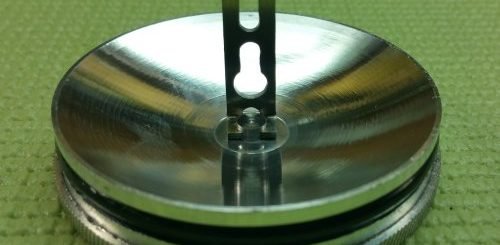Kelty Peregrine Daypack
The Kelty Peregrine occupies the interesting middle ground of the daypack world. It offers some solid improvements from less expensive packs, but without the meticulous attention to detail found in pricier models. There have been necessary compromises to keep the price tag of this bag in the $50 to $75 range. The same model is advertised both as the Kelty Peregrine 29 and the Kelty Peregrine 1800. Kelty confirmed that these are the same item, just listed by volume as either 29 liters or 1800 cubic inches.
There is a mesh pocket on each side of of the pack for carrying water bottles. A 32oz Nalgene bottle is a perfect fit. Larger items could also be put into these pockets and secured under the straps on the side of the pack.
The side compression straps are a nice upgrade from inexpensive packs. They allow you to cinch down your load and smush it in closer to your back. This is handy if the bag is only half full and you do not want the contents bouncing around while you walk. It is also a big plus if you pack is full of fluff, like a cold weather jacket, small tarp or a poncho, than can be compressed down into a smaller, less bulky load.
At the bottom of the daisy chain running down the back of the pack is a single ice axe loop. Since most people’s preparedness plans do not include ice axes, it seems rather pointless. But, if you keep some 550 cord in the smallest pocket of the pack, then the ice axe loop comes in handy when you need to quickly lash something like a wet tarp or a bike helmet to the back. Combined with the side compression straps and the rear daisy chain loops, you have some good attachment points to work with.
The bottom of the pack is 1000D urethane coated Kodra nylon with the outside of the body being made of 500D Kodra. Kodra is made by Kolon Industries in Korea. It is similar to the Cordura fabric of DuPont fame, but a different product. This type of fabric is designed for abrasion resistance and has been a standard in making durable packs for years.
The top carry handle is made from a single piece of nylon webbing. The sides have been folded over and sewn to provide a more comfortable grip.
Where the carry handle meets the seams on the top of the pack has been reinforced.
The Peregrine is a three compartment pack. The smallest compartment is accessed by a zipper on the left side of the daisy chain. It is almost T-bone shaped and large enough for a first aid kit or a light rain jacket and a nice piece of 550 cord. This is a good place to keep small items that are needed either frequently or in a hurry.
All of the zippers are YKK brand, which are known for making high quality fasteners. Zippers certainly are not magic, but the cheap ones have a bad habit of busting loose at the most inopportune times. Most daypacks do not have any kind of redundant system, such as a back panel with multiple straps, to back up a failed zipper. If you are stuck using a cheap pack with zippers of unknown origin, a quick fix is to keep a ziploc bag with a handful of large safety pins stashed inside for emergency repairs.
The secondary compartment is large enough to hold a small tarp. It has administrative organizer with a large back pocket, two half size front pockets, a zippered pouch, key keeper and three pen pouches. The largest pen type pouch is almost exactly Zippo lighter sized while the half pockets are large enough to hold any of the flashlights tested in our flashlight comparison article.
The inside of the secondary compartment has a microfleece type pocket on the inside of the lid. It is designed to hold glasses, goggles or other eyewear and hold shut with a velcro tab.
The main compartment makes up the majority of the pack’s storage space. In waterproofness tests, there was a little water on the inside of this compartment after five minutes of exposure to simulated rain. The pack material was fine, water was leaking in through the seams. But, to be fair, I’ve had the same thing happen to packs costing over two hundred dollars. The easiest fix for this is to keep a trashbag in your pack and put anything that really needs to stay dry in the trashbag, if it looks like rain. Trashbags also make decent emergency ponchos, if you cut small head and arm holes.
The backpanel of the main compartment also has a large elastic edged pouch and toggles for securing a hydration reservoir.
There is a neoprene patch in the top center of the the backpanel for feeding hydration tubes out of the pack.
The padding across the back of the pack is a very lightweight closed cell foam. There are three mesh areas with thicker padding and a Y shaped channel in between for airflow. This helps to keep your back cool on hot days. The backpanel of the Peregrine is, somewhat disappointingly, made of a lighter weight nylon than the rest of the outside. Is is the same nylon material used inside the pack.
The “frame” of the pack is a Delrin support rod that loops across the inside of the back panel.
The hipbelt is of the minimalist variety and can be removed. The side release buckles used on the hipbelt, compression straps and sternum strap are various sizes of the Stealth model made by Woojin Plastics. I’ve had buckles made by this company on other gear in the past, including an REI pack that has seen a good amount of use. As of yet, they have performed without any problems. There is an obvious difference in the feel between a good plastic buckle that is going to last and a budget Chinese buckle.
The shoulder straps can be adjusted from both the top and the bottom. This means they can be moved down to give a better fit on larger folks or people wearing bulky clothing. A hydration tube can be secured under the elastic bands on the top of the shoulder pads. The sternum strap has three quarters of an inch of give built into it with an elastic band backed up with nylon webbing.
The shoulder straps are reinforced where they meet the body of the pack. This is a common point of failure on less expensive packs as the weight of the load will pull the stitching out of the seam, unless something is done to back it up. This is certainly a mark in the Peregrine’s favor.
A point of concern is with the construction of the shoulder straps. There is a thermoplastic sheet inside the top extension piece that is sewn into the pack body. The arrow in the picture above marks where the plastic insert ends before the strap reaches the pack body. Although there are not any examples of this being an issue at the moment, it would be worth keeping an eye on this spot in future years as a place for potential wear if the corner of this insert rubs against the inside of the nylon strap.
Adjusting the top of the shoulder strap for a good fit takes a few steps.
First, you have to unthread the tail of the nylon webbing that connects to the top of the pack.
Then, that is threaded backwards through the plastic buckle, so the slack feeds out towards the top of the pack.
Once that strap is unbuckled, push two or three fingers up under the nylon covered plastic tab to loosen the velcro. When adjusting the strap length, put a business card between the two velcro halves until you get the length where you want it. That way, you will not have to fight it to make adjustments. Then, just slide the business card out and rethread the nylon strap back through the buckle. If you adjust one strap at a time, then you can use the other strap as a reference as to which way to feed the nylon webbing back through the buckle to reattach it to the pack.
In summary, if you are currently using a daypack at the bookbag level of build quality, this pack is a nice step up, especially if you can catch it on sale for around the fifty dollar price point. It would be an excellent “trunk bag” for your car or a “get home bag”. With space for a hydration reservoir and two Nalgene bottles on the side, it could hold over 150 ounces of water and still have room for some basic gear on the inside. However, I do not really see this as a true specialty pack. It is a mainstream pack with some specialty features added into the mix. If it is compared against packs in the under fifty dollar range, those extra features and the reinforcement of key stitch points make it well worth the extra money. If you are looking for a true specialty pack for daily carry in harsh environments, then it would be worth stepping up to a more serious bag that is a step up in materials and build quality. That said, the Kelty Peregrine offers good value, as long as it’s limitations are understood.



